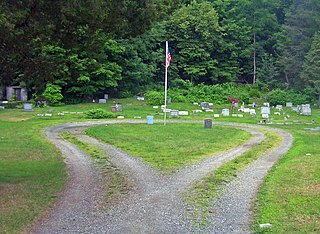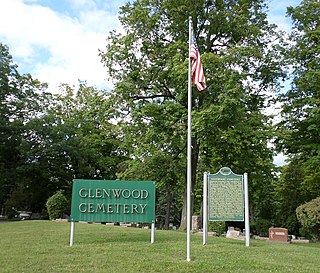
Sloatsburg is a village in the town of Ramapo in Rockland County, New York, United States. Located east of Orange County, it is at the southern entrance to Harriman State Park. The population was 3,039 at the 2010 census. The village is named after Stephen Sloat, an early European landowner.

Green-Wood Cemetery is a 478-acre (193 ha) cemetery in the western portion of Brooklyn, New York City. The cemetery is located between South Slope/Greenwood Heights, Park Slope, Windsor Terrace, Borough Park, Kensington, and Sunset Park, and lies several blocks southwest of Prospect Park. Its boundaries include, among other streets, 20th Street to the northeast, Fifth Avenue to the northwest, 36th and 37th Streets to the southwest, Fort Hamilton Parkway to the south, and McDonald Avenue to the east.

Mount Auburn Cemetery is the first rural, or garden, cemetery in the United States, located on the line between Cambridge and Watertown in Middlesex County, Massachusetts, 4 miles (6.4 km) west of Boston. It is the burial site of many prominent Boston Brahmins, as well as being a National Historic Landmark.

Vale Cemetery is a historic rural cemetery and the largest cemetery in Schenectady, New York. It opened on 21 October 1857 when the Rev. Julius Seely dedicated what was then termed "the Vale". It has tripled its size since opening and today it holds the remains of some of the most notable persons in Upstate New York. In 1973, a 35-acre tract of unused and abandoned cemetery land around the ponds of Cowhorn Creek was sold to the city of Schenectady to form Vale Park.

Hillside Cemetery is located on Mulberry Street in Middletown, New York, United States. Opened in 1861, it was designed in the rural cemetery style by Calvert Vaux and Frederick Law Olmsted, later noted for their collaboration on Central Park. There are several thousand graves, some with excellent examples of 19th-century funerary art.

Chelsea Garden Cemetery is a historic rural cemetery in Chelsea, Massachusetts. The cemetery was established in 1841 to provide the city a burying ground in the then-fashionable rural cemetery style, and was the first cemetery within the city limits. It was added to the National Register of Historic Places in 2001.

Oakwood Cemetery is a nonsectarian rural cemetery in northeastern Troy, New York, United States. It operates under the direction of the Troy Cemetery Association, a non-profit board of directors that deals strictly with the operation of the cemetery. It was established in 1848 in response to the growing rural cemetery movement in New England and went into service in 1850. The cemetery was designed by architect John C. Sidney and underwent its greatest development in the late 19th century under superintendent John Boetcher, who incorporated rare foliage and a clear landscape design strategy. Oakwood was the fourth rural cemetery opened in New York and its governing body was the first rural cemetery association created in the state.

Glenwood Cemetery is a historic rural cemetery northeast of Parker Street and Great Road in Maynard, Massachusetts. It is one of the first municipal creations of the town after its incorporation in 1871, and is the resting place of many of its early and prominent residents, including Amory Maynard, founder of the Assabet Woolen Mill and namesake of the community. The cemetery was added to the National Register of Historic Places (NR#04000425) on May 12, 2004.

The Old Sloatsburg Cemetery is located at the end of Richard Street in Sloatsburg, New York, United States. It began as the Sloat family cemetery with the burial of Revolutionary War casualty John Sloat in 1781. After a half-century of inactivity, it gradually was expanded to include 1,200 graves by the time of the last burial in 1949.

Millville Cemetery is located on East Shelby Road in Millville, New York, United States. It was established in 1871 as a rural cemetery, expanding on an early burial ground.

Machpelah Cemetery is located on North Street in Le Roy, New York, United States. It was opened in the mid-19th century and expanded since then. Graves from other, smaller burial grounds around Le Roy have been added. It was listed on the National Register of Historic Places in 2007, one of two cemeteries in Genesee County with that distinction.

The Revolutionary War Cemetery, also called the Old Salem Burying Ground, is located on Archibald Street, just off state highway NY 22 in the village of Salem, New York, United States. It is a 2.6-acre (1.1 ha) area with over a thousand graves, at least 100 of which are those of Revolutionary War dead or veterans.

The Sharp Burial Ground, also known as the Albany Avenue Cemetery, is located on Albany Avenue in Kingston, New York, United States. It is a small burying ground used during the middle decades of the 19th century, before larger rural cemeteries had become common but after churchyards had become too full for further burials. Later, when they did open, many bodies were removed to consolidate them with larger family plots there. Two former congressmen are still among those buried at Sharp.

The English coastal city of Brighton and Hove, made up of the formerly separate Boroughs of Brighton and Hove in East Sussex, has a wide range of cemeteries throughout its urban area. Many were established in the mid-19th century, a time in which the Victorian "cult of death" encouraged extravagant, expensive memorials set in carefully cultivated landscapes which were even recommended as tourist attractions. Some of the largest, such as the Extra Mural Cemetery and the Brighton and Preston Cemetery, were set in particularly impressive natural landscapes. Brighton and Hove City Council, the local authority responsible for public services in the city, manages seven cemeteries, one of which also has the city's main crematorium. An eighth cemetery and a second crematorium are owned by a private company. Many cemeteries are full and no longer accept new burials. The council maintains administrative offices and a mortuary at the Woodvale Cemetery, and employs a coroner and support staff.

Glenwood Cemetery is a historic cemetery located at 2219 Lincoln Road NE in Washington, D.C. It is a private, secular cemetery owned and operated by The Glenwood Cemetery, Inc. Many famous people are buried in Glenwood Cemetery, and the cemetery is noted for its numerous elaborate Victorian and Art Nouveau funerary monuments. The cemetery was listed on the National Register of Historic Places in 2017; its mortuary chapel was separately listed in 1989.

The Blossom Hill and Calvary Cemeteries are a pair of adjacent municipally-owned cemeteries on North State Street in Concord, New Hampshire. Blossom Hill, a 19th-century cemetery designed in the then-fashionable rural cemetery tradition, was always a municipal cemetery; the Calvary Cemetery was established by the Roman Catholic Diocese of Manchester, whose oversight area includes all of New Hampshire. The Calvary Cemetery was taken over by the city in 1995; its earliest marked grave dates to 1857. The cemeteries were listed on the National Register of Historic Places in 2010.

Ridgewood Cemetery is a historic cemetery at 177 Salem Street in North Andover, Massachusetts. Organized in 1849 and opened in 1850, it is the town's third cemetery, and the first in the then-fashionable rural cemetery style. It was listed on the National Register of Historic Places in 2016. It is owned and operated by a non-profit cemetery association, and remains in active use, with about 3,000 marked burials.

Glenwood Cemetery is a cemetery located at 2500 W Court Street in Flint, Michigan. It was listed on the National Register of Historic Places in 2010.

The Historic Cemeteries of New Orleans, New Orleans, United States, are a group of forty-two cemeteries that are historically and culturally significant. These are distinct from most cemeteries commonly located in the United States in that they are an amalgam of the French, Spanish, and Caribbean historical influences on the city of New Orleans in addition to limitations resulting from the city's high water table. The cemeteries reflect the ethnic, religious, and socio-economic heritages of the city. Architecturally, they are predominantly above ground tombs, family tombs, civic association tombs, and wall vaults, often in neo-classical design and laid out in regular patterns similar to city streets. They are at times referred to colloquially as “Cities of the Dead”, and some of the historic cemeteries are tourist destinations.
























